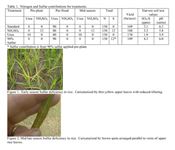Specialists Share Sulfur Trial Results At Delta Center Field Day
DAVID DUNN
PORTAGEVILLE, MO.
Sulfur (S) is an essential plant nutrient. In previous years S was delivered free to the farm by rain. Volcanoes and fossil fuel burning power plants release millions of tons of S annually. This S was then brought to earth with rain and snow. While the government cannot regulate volcanoes the EPA has restricted S emissions from fossil fuels.
Sulfur deficiencies in rice are increasing each year. Sulfur and Nitrogen deficiencies in rice both look similar with a yellowing of the leaves. However, Sulfur deficiency is first expressed in the youngest leaves, while Nitrogen is expressed first by the oldest leaves. Sulfur deficient rice looks different in the early season than in the late or mid-season. In the early season sulfur deficient rice is yellow and thin in the upper leaves with reduced tillering (Figure 1). Latter in the year Sulfur deficiency is expressed as regularly arranged brown spots on the upper leaves. These spots resemble brown spot disease but are arranged parallel to the leaf veins (Figure 2)
The University of Missouri recommends applying S only on soil with a CEC of less than 6.5. This would preclude sulfur fertilization for most rice production fields. This recommendation was developed during the early 1970s and reflects sulfur carried to the soil by rainfall. This study was conducted to evaluate Sulfur fertilization of rice.
Two pre-plant sulfur treatments were compared to the standard nitrogen fertilization for cultivating rice. A pre-plant urea treatment was included to verify if yield differences in the ammonium sulfate (NH4SO4) treatment were due to a sulfur or nitrogen effect. The total amount of nitrogen supplied to each plot was 150 lbs/acre. Nitrogen rates for pre-plant N treatments were balanced by deducting the corresponding N from the pre-flood rate. These treatments are listed in Table 1. Soil samples were collected from each plot at harvest. These samples were analyzed for pH and SO4-S.
The yields for both sulfur treatments were numerically greater than for the urea treatments (Table 1). The average numerical yield advantage for the sulfur treatment was 19 bu/acre. At harvest SO4-S soil test levels for both sulfur treatments were significantly greater than the urea treatments. SO4-S levels for the 90 percent sulfur treatment were numerically greater than the NH4SO4 treatment. Post-harvest SO4-S levels indicate that sulfur build up should not be a problem. Soil pH levels were significantly lower for sulfur treatments at pre-flood. At harvest only the NH4SO4 treatment was significantly different. The NH4SO4 treatment lowered post-harvest pH by 0.4 units.
While sulfur pre-plant fertilization did not significantly increase rice yields, the numerical yield advantage (19 bu/acre) for these treatments is compelling. An added benefit of pre-plant Sulfur was that the rice began tillering 2-3 days earlier. At current prices for ammonium sulfate adding 12 of sulfur per acre (50 lbs NH4SO4) adds $5-$7 per acre to production costs. Rice producers should soil test for SO4-S and consider pre-plant sulfur fertilization for fields testing low.
This research was made possible by the generous support of the Missouri Rice Research and Merchandising Council. ∆
DAVID DUNN: Extension Associate Soil Testing Lab, University of Missouri
